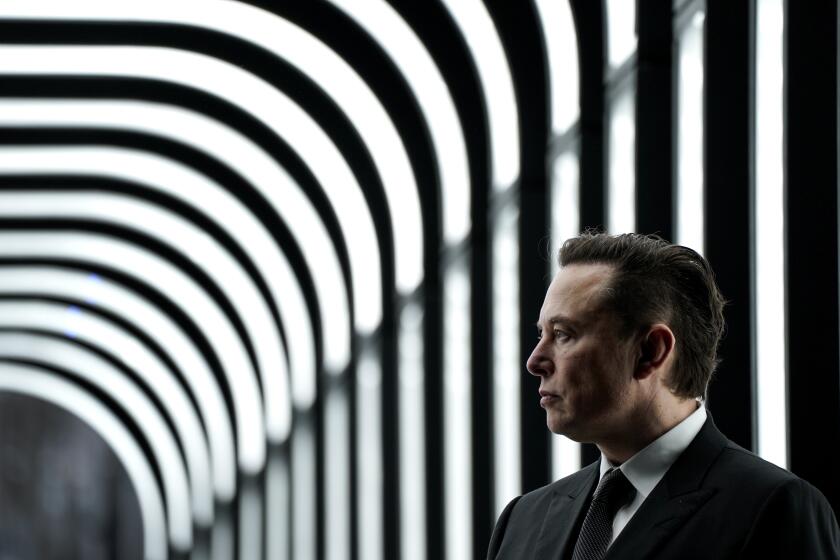Best of 2007: French roll

- Share via
“Know then thyself, presume not God to scan; The proper study of mankind is Man.”
-- Alexander Pope
Want to know thyself better? Gauge your reaction to this car, the Smart Fortwo, a four-wheeled flea built by Smart -- a subsidiary of DaimlerChrysler -- to be imported to the U.S. in the first quarter of 2008. Measuring 106.1 inches long and weighing just under 1,650 pounds, the Fortwo soon will be, by an astonishing margin, the smallest gas-powered car on the market: nearly 40 inches shorter than the BMW Mini, a whopping four feet shorter than the Scion xA. This is car design as seen through the wrong end of the telescope.
Cute? Oh my God, yes. It couldn’t be any cuter if it were buried up to its neck in kittens. Attention grabbing? Ice cream trucks playing “La Bamba” at 100 decibels don’t get more notice. Likable? It’s irresistible. The Smart is a rolling sight gag, like a fat man wearing a tiny bowler hat, or a Speedo.
Safe? Can we go back to “likable”? At roughly a third the weight of a large luxury sedan -- like Mercedes’ S-class -- the Fortwo would be at a profound Newtonian disadvantage in most any vehicle-to-vehicle collision.
So, the first question potential buyers must consider is a cosmic version of: Do I feel lucky? The Fortwo -- sold in 36 countries and a familiar sight to anyone who has traveled abroad -- is supposed to be a very safe car. I’m sure it is, relatively. The cabin is surrounded by something called the Tridion safety cell, a highly reinforced steel superstructure designed to deform and redistribute crash energy away from the occupants. The cars coming to the U.S. will have anti-lock brakes, stability control, reinforced doors and front and side air bags.
The trouble lies not so much in the car but with the American driving environment that, unlike Europe’s, is filled with 3-ton trucks and SUVs, for which the Fortwo is no more than a snack. It is a dolorous fact of physics that when two vehicles meet head-on, the occupants in the lighter vehicle are almost instantly accelerated backward. Brains, aortas and other soft tissues do not care for this at all. The Fortwo’s evident lack of energy-absorbing crumple zones makes this issue even more acute.
The solution, naturally, is not to hit anything or be hit. In my short time in the Fortwo, I adopted the kind of hyper-vigilance/paranoia I usually reserve for riding motorcycles. The religiously minded may consider investing in icons of the plastic dashboard-mounted variety. Know thyself.
Smart has taken a bumpy route to the U.S. The Boblingen, Germany-based company -- formed in 1994 as an alliance between the Swiss watchmaker Swatch and then-named Daimler-Benz -- has lost piles of cash, somewhere in the neighborhood of $4 billion since 1998. The company had planned to come to the American market in 2006 with the Formore -- a tiny SUV based on a Mercedes C-class chassis -- but pulled the plug on that in 2005 as the Chrysler division’s losses began to drag down the parent company.
The current effort is a more modest enterprise headed by auto entrepreneur Roger Penske, whose company has created Smart USA to market and distribute the cars. Smart USA hopes to sell about 20,000 cars in the first year through about 70 dealerships nationwide.
Returning to Pope’s admonition: If you find yourself drawn to the Fortwo, you are probably an iconoclast, a real dyed-in-the-wool-beret Europhile. Unless I’m much mistaken, the Fortwo is the first French-built car to come to the U.S. in decades (Smart’s factory is in Hambach, France). In other words, to buy the Fortwo is to bite your thumb at old Bill O’Reilly. The Fortwo has the same sort of winning maneuverability and lowercased sportiness of the old Citroen 2CV. (Incidentally, Citroen’s famous “Tin Snail” and the Fiat 500 are both being revived to satisfy Europe’s growing appetite for super-thrifty city cars.)
There is no getting around it: The Fortwo is a minor hoot to drive. U.S.-spec cars will have a 1-liter, 70-hp, three-cylinder engine wedged in the back under the cargo hold. The cars will come with a five-speed sequential gearbox with optional shifter paddles behind the steering wheel; this gearbox has an automatic mode that offers convenient though spectacularly sluggish cog changing. The Fortwo is also rear-wheel drive.
Got that? A rear-engine, rear-wheel-drive two-seater, with manumatic shifting. Think of it as the world’s dorkiest Porsche.
Despite the lack of horseflesh, the Fortwo is a lively little cavort. The engine revs fiendishly to its 6,500-rpm redline and the gearing is such that the car can nick through city traffic easily. Block to block, stoplight to stoplight, the car’s straight-line performance is a non-issue. The paddle shifters are a big help. When it comes to getting on the freeway, the Fortwo requires more patience and a cruel disregard for the squealing engine but it does manage to reach highway speeds in about 16 seconds. Once up to speed, the Fortwo will comfortably maintain 80 mph, which is just enough to keep you from getting mowed down on Interstate 5.
As for handling, it doesn’t, much. In order to make the ride tolerable in this wee wheelbase vehicle, the suspension has been set very soft; take a corner quickly and the Fortwo lolls and rolls like it’s on old bedsprings. And yet, even this quality has a quirky fun factor.
Inside the cabin, the Fortwo is not just roomy but positively spacious. The high roof offers lots of headroom and the transparent roof (in the upfitted “Passion” edition) lends the car an unexpected airiness. The cargo capacity is surprising. I piled 10 bags of groceries and two cases of water in the back without a problem. The Cabrio model has a canvas top that retracts electrically from between the fixed roof rails. Leg room and shoulder room are ample. From the driver’s seat you could assume you were in any other compact car until you look over your shoulder to discover that, lo, it appears someone has stolen the back half of the car.
There are three strong, perhaps insurmountable, objections to the Fortwo: First, the price. The base model (Pure) will run about $12,000; the Passion will run about $14,000. Unfortunately, in the time it’s taken to get this car to the States, several other bigger, better-equipped cars have come in at around those price points -- e.g., the Kia Rio, Toyota Yaris and Chevy Aveo (which, not irrelevantly, got a five-star frontal crash rating from the government).
Second, the Fortwo’s greatest asset, its size, doesn’t really have much of a payoff on America’s broad boulevards and avenues. Unlike the back streets of, say, Siena, American cities are scaled to accommodate much larger vehicles. Meanwhile, it’s not at all clear that municipalities will allow the Smart car to perform its neatest trick -- parking perpendicular to the curb.
Last, fuel economy: The 1-liter car gets less than 40 miles per gallon in mixed driving -- good but not great, considering that the Honda Civic Hybrid and Toyota Prius return about the same mileage in much larger, more usable cars.
The Smart was a revolutionary idea in the 1990s, but the revolution has swept past. It’s winsome and fun and -- as I discovered -- a shameless chick magnet. But in the rapidly diversifying market you can get more car for less.
Smart, on the other hand, offers you less car for more.
dan.neil@latimes.com
*
Smart Fortwo
Base price: $12,000 (est.)
Price, as tested: $14,000
Powertrain: 1.0-liter, DOHC three-cylinder engine; five-speed sequential transmission with electro-hydraulic clutch; rear-wheel drive.
Horsepower: 70 at 5,800 rpm
Torque: 68 pound-feet at 4,800 rpm
Curb weight: 1,650 pounds
0-60: 15.5 seconds
Wheelbase: 73.5 inches
Overall length: 106.1 inches
EPA fuel economy: 31 miles per gallon city, 43 mpg highway
Final thoughts: Lovable, only don’t hug too hard
NOTE: Photos are uncropped archival versions and may differ from published versions.





